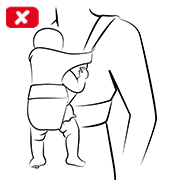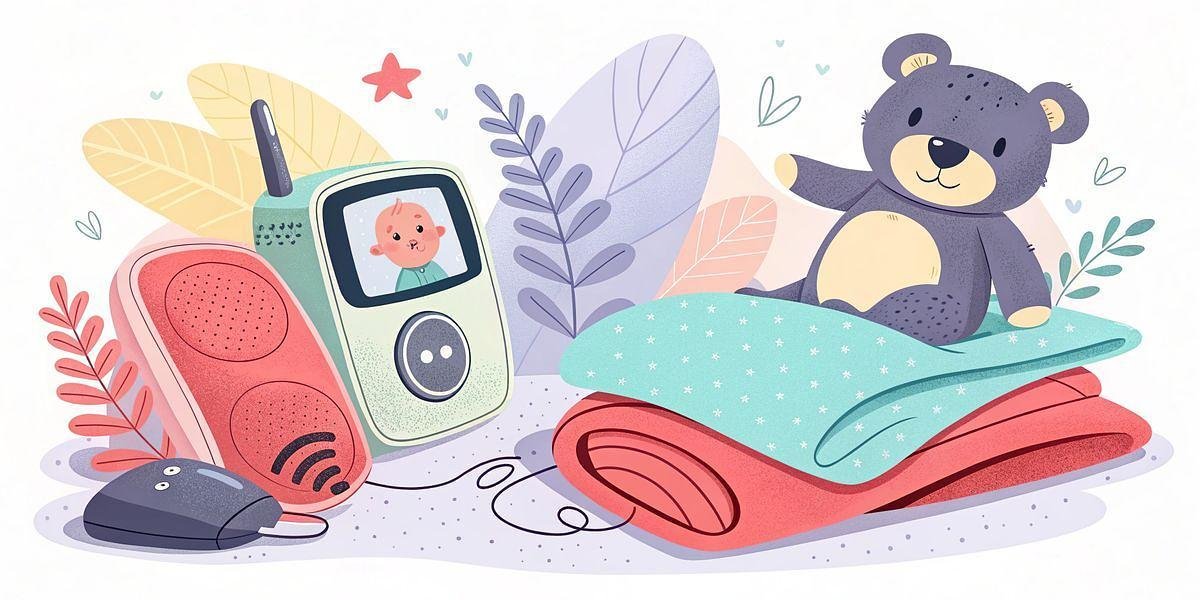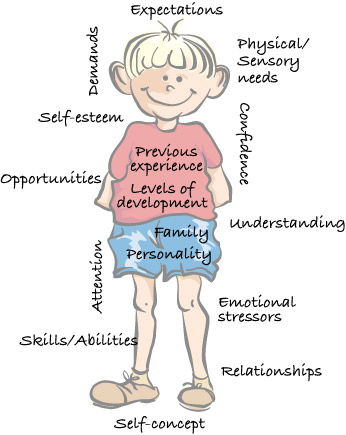Have you ever felt overwhelmed when trying to figure out the proper way to wear a baby carrier? You’re not alone.
Many parents find themselves puzzled by the array of straps, buckles, and adjustments. But worry no more! This article is here to guide you through each step, ensuring that both you and your little one enjoy a comfortable and secure experience.
Imagine the peace of mind you’ll have knowing your baby is safe and snug, while your hands are free to tackle everyday tasks. With this knowledge, you can confidently embrace the joys of parenthood without the stress. Keep reading to unlock the secrets to mastering the baby carrier, and transform your daily routine into a bonding experience you’ll cherish forever.
Credit: infantino.com
Choosing The Right Baby Carrier
Choosing the right baby carrier can feel overwhelming with so many options available. But it’s crucial to pick the one that suits your needs and ensures comfort for both you and your baby. Let’s break down the essentials to guide you in making the perfect choice.
Comfort For You And Your Baby
Your comfort is as important as your baby’s. Consider carriers with padded straps and waistband. They help distribute weight evenly, reducing strain on your back and shoulders.
Check for adjustable features. This allows you to customize the fit as your baby grows. A snug fit keeps your baby secure and cozy.
Consider Your Lifestyle
Think about how often you’ll use the carrier. Are you planning short walks, or do you need it for daily errands? Some carriers are designed for long-term wear, while others are better for quick trips.
If you’re an active parent, look for a carrier that’s easy to clean and durable. You want something that can handle spills and frequent use.
Safety First
Safety is non-negotiable. Ensure the carrier meets all safety standards. Look for certifications and read reviews from other parents.
Check for secure buckles and straps. You don’t want any surprises when you’re on the go.
Ease Of Use
Ask yourself, how easy is it to put on and take off the carrier? Some models are straightforward, while others require a bit more practice.
Consider if you’ll be using it solo or if you’ll have help. This can influence the type of carrier that’s best for you.
Budget Matters
Baby carriers come in a range of prices. Set a budget, but remember that quality and comfort are investments in your and your baby’s well-being.
Sometimes, spending a little more for added features and comfort is worthwhile. Check reviews to ensure you’re getting value for your money.
Choosing the right baby carrier isn’t just about personal preference; it’s about finding what works best for your lifestyle and needs. Have you considered what features matter most to you? With the right carrier, every outing becomes a chance to bond closely with your little one while keeping both of you comfortable and secure.
Adjusting Straps For Comfort
Ensure a snug fit by adjusting the carrier straps to prevent strain. Check the straps for even distribution. This provides comfort and safety for both you and your baby.
Adjusting the straps of a baby carrier is crucial for both comfort and safety. You want your baby to be secure, but you also need to feel comfortable as you carry them. Imagine a day where you and your baby are out on an adventure, and the straps are digging into your shoulders. That’s not fun for anyone. Properly adjusted straps can make all the difference between a pleasant experience and a struggle.
Understanding Strap Types
Different carriers come with various strap systems. Some have padded shoulder straps, while others might offer a waist belt. Knowing what type of straps your carrier has can help you adjust them effectively. Check if they are adjustable or fixed. If they’re adjustable, you’re in luck—there’s more room to play around for comfort.
Start With Shoulder Straps
Shoulder straps are often the first point of adjustment. Loosen them if they’re too tight, but ensure they’re not so loose that the carrier sags. A snug fit keeps your baby closer to your body, which is ideal for balance and support. Test the comfort by wearing the carrier for a few minutes. Do you feel the weight evenly distributed?
Adjust The Waist Belt
The waist belt is your friend for lower back support. Position it slightly above your hips for optimal comfort. Tighten it until it feels secure but not constricting. This helps in transferring the weight from your shoulders to your hips. If you’re planning a long walk, this can prevent back pain.
Fine-tune Chest Strap
Not all carriers have a chest strap, but if yours does, use it to stabilize shoulder straps. It helps prevent them from slipping off. Adjust the chest strap to sit comfortably across your chest, not too high or too low. A well-positioned chest strap can offer added security.
Listen To Your Body
Your body will tell you if something feels off. If you feel discomfort, revisit the straps. Sometimes, a small tweak can make a big difference. Are the straps pinching your skin? Is there undue pressure on one side? If yes, adjust until it feels right.
Engage In The Experience
Think about how you move with the carrier. Do you bend frequently or reach for items? Your movements impact how the straps feel. Adjustments should accommodate your lifestyle. Consider testing the setup by going about your daily tasks for a while.
Ask Yourself: Is This Comfortable?
The ultimate test is comfort. Do you feel at ease? Is your baby happy? If the answer is yes, then you’ve likely nailed the adjustments. Remember, comfort is not just about physical ease but peace of mind as well. Your baby’s comfort contributes to your overall experience. Take a moment to reflect: are you willing to readjust and try different settings for the best fit? Comfort is essential for enjoying those precious moments with your baby.
Ensuring Baby’s Safety
Wearing a baby carrier correctly is crucial for your little one’s safety. Parents often wonder how to ensure their baby’s comfort and security. It’s important to follow guidelines and check regularly. This ensures your baby is protected while you enjoy hands-free time.
Let’s explore key tips for keeping your baby safe in a carrier.
Check Carrier’s Fit
Always adjust the carrier to fit snugly. A tight fit provides support. Loose carriers can cause discomfort or risk falling. Ensure all straps are fastened securely.
Position Baby Correctly
Keep your baby high on your chest. Their head should be close enough to kiss. This position helps maintain eye contact and ensures proper airflow.
Support Baby’s Head
Support your baby’s head and neck. Newborns need extra care. Adjust the carrier to provide adequate neck support.
Monitor Breathing
Always ensure your baby’s face is visible. Check their breathing regularly. Avoid covering their face with fabric or clothing.
Choose The Right Carrier
Select a carrier suitable for your baby’s age. Different carriers fit various stages of growth. Ensure it meets safety standards.
Inspect For Wear And Tear
Regularly check the carrier for damage. Look for frayed fabric or broken straps. Replace if necessary to ensure safety.
Maintaining Correct Posture
Wearing a baby carrier properly ensures comfort and safety for both parent and child. Adjust straps snugly to distribute weight evenly. Keep the baby’s head close enough to kiss and ensure their back is supported. Correct posture reduces strain, making the experience enjoyable for everyone.
Wearing a baby carrier is a delightful experience. It keeps your little one close and offers hands-free convenience. Yet, maintaining correct posture is crucial for both you and the baby. A proper posture ensures comfort and safety, reducing strain on your back. It also promotes healthy hip development for your baby. Let’s explore the best practices for maintaining correct posture while using a baby carrier.
Ensure Baby’s Head Is Supported
Always check that the baby’s head is well-supported. This prevents neck strain and discomfort. Adjust the carrier to keep the head snug against your chest. Ensure that the baby’s chin is not touching their chest. This allows for clear airways and easy breathing.
Align Your Back Straight
Keep your back straight to avoid discomfort. Standing tall helps distribute the baby’s weight evenly. Avoid slouching, as it puts pressure on your lower back. Adjust the carrier straps to keep the baby high and close. This reduces the chance of back pain.
Position Baby’s Legs Properly
Baby’s legs should form an “M” shape. This position supports healthy hip development. Ensure the thighs are supported from knee to knee. The knees should be higher than the bottom. This provides comfort and safety for your baby.
Adjust Straps For Comfort
Properly adjusted straps are key to a good fit. Tighten them to hold the baby close, but not too tight. Ensure you can fit two fingers between the strap and your body. This prevents discomfort and allows for free movement. Regularly check and adjust as needed. `
Different Carrying Positions
Carrying a baby in a carrier offers various positions like front, hip, and back carrying. Each position supports the baby’s comfort and safety. Adjust straps to ensure a snug fit, keeping the baby close and secure. Always maintain the baby’s head and neck properly supported.
Wearing a baby carrier correctly can be a game changer for both you and your little one. Understanding different carrying positions is crucial. Each position offers unique benefits for your baby’s comfort and your ease. Plus, getting the right position can make a world of difference during those long walks or quick errands. So, let’s dive into the world of baby carriers and discover how you can make them work best for you and your child.
Front Carry Position
The front carry position is one of the most popular choices for newborns and infants. It keeps your baby close to your chest, allowing them to hear your heartbeat and feel your warmth. This position is great for bonding, especially during those first few months. Imagine a quiet afternoon stroll where you can whisper gentle words to your baby while they rest against you.
Back Carry Position
As your baby grows, the back carry position might become your go-to. It offers more freedom for your movements, making it ideal for busy parents. This position is perfect for active days when you need both hands free. Think of it as having your little explorer on your back, ready for an adventure while you tackle tasks around the house or enjoy a walk in the park.
Hip Carry Position
The hip carry position provides a versatile option for older babies who want to see the world around them. This position allows your child to have a better view of their surroundings while still being close to you. It’s perfect for those curious toddlers who want to be part of the action. Imagine navigating a crowded market with your baby happily perched on your hip, watching and learning from the bustling environment.
Kangaroo Carry Position
The kangaroo carry position is designed for premature babies or newborns who need additional support. It mimics the natural fetal position and provides skin-to-skin contact, promoting warmth and comfort. This position can be a lifesaver for comforting a fussy baby, creating a secure and nurturing environment reminiscent of the womb.
Cradle Carry Position
The cradle carry position is ideal for breastfeeding or soothing a sleepy baby. It allows easy access for nursing and keeps your baby snugly in your arms. This position is reminiscent of the classic cradling method that many parents instinctively use. Picture a peaceful evening, rocking gently as your baby drifts off to sleep, securely cradled in the carrier. Each carrying position has its own charm and utility. Consider what suits your lifestyle and your baby’s needs. Which position do you think will enhance your daily routine and create memorable moments with your little one?

Credit: raisingchildren.net.au
Caring For Your Baby Carrier
Ensure the baby carrier fits snugly against your body for comfort. Adjust the straps to support your baby’s head and neck. Keep your baby’s hips in a healthy position to promote proper development. Regularly check the carrier’s buckles and seams for any signs of wear.
Caring for your baby carrier is essential for maintaining its quality and ensuring your baby’s safety. A well-maintained carrier can serve you reliably and comfortably. Plus, it can save you money by lasting through multiple uses or even multiple children.
Understand The Fabric
Before cleaning, take a moment to understand the fabric of your baby carrier. Each material has its own care instructions. Cotton might be machine washable, while delicate fabrics may require hand washing.
Regular Cleaning Routine
Set up a regular cleaning schedule for your carrier. Spot clean any spills or stains immediately to prevent them from setting. A quick wipe with a damp cloth can often do the trick.
Proper Storage
Always store your baby carrier in a dry place. Avoid direct sunlight to prevent fading and weakening of the fabric. Consider a dedicated space in your closet or nursery for easy access.
Inspect For Wear And Tear
Regularly inspect your carrier for any signs of wear and tear. Check straps, buckles, and stitching to ensure they remain secure. A small tear or loose thread can quickly turn into a bigger issue.
Follow Manufacturer’s Instructions
Always refer to the manufacturer’s guidelines for specific care tips. They know their product best. Following their advice can prolong the life of your carrier.
Share Your Carrier Story
Have you ever shared your carrier with a friend or family member? Sharing can sometimes lead to unexpected wear, so inspect it thoroughly afterward. Consider sharing tips on how to care for it with them.
Consider Professional Cleaning
If your carrier is heavily soiled, consider professional cleaning services. This can be particularly useful for carriers with intricate designs or materials. It might be more cost-effective than you think.
Engage With The Community
Join parenting forums or social media groups for tips on carrier care. Others’ experiences can offer valuable insights. Have you found a unique way to maintain your carrier? Share it with others and learn from their experiences. Taking the time to care for your baby carrier pays off in the long run. What unique methods have you found to keep your carrier in top shape?

Credit: sheenslings.com
Frequently Asked Questions
How Do I Position My Baby Correctly?
To position your baby correctly, ensure their face is visible and clear of fabric. Their head should be supported, and their legs should form an “M” shape. Adjust the carrier straps for a snug fit, keeping your baby close enough to kiss for optimal safety and comfort.
Is My Baby Carrier Too Tight?
Your baby carrier is too tight if your baby seems uncomfortable or restricted. You should be able to fit two fingers between your baby and the carrier. Adjust straps for a snug, but not tight fit. Comfort is key for both you and your baby during use.
Can Newborns Use Baby Carriers Safely?
Yes, newborns can use baby carriers safely with proper support. Choose a carrier designed for newborns, offering head and neck support. Ensure the carrier provides a secure fit, keeping your baby’s face visible and airway clear. Always follow manufacturer instructions for maximum safety and comfort.
How Long Can I Wear A Baby Carrier?
You can wear a baby carrier for several hours, but take breaks as needed. Monitor your baby’s comfort and adjust positions periodically. Listen to your body, ensuring you’re comfortable too. Regularly check your baby’s position to maintain safety and provide optimal support during use.
Conclusion
Wearing a baby carrier correctly keeps your child safe and comfortable. Always ensure the carrier fits snugly and supports the baby’s head. Check that the baby’s hips are in a healthy position. Adjust straps for your comfort and balance. Remember to keep the baby close enough to kiss.
This ensures they are at the right height. Regularly inspect your carrier for any signs of wear. Practice these steps to make outings enjoyable. Both for you and your baby.








2 thoughts on “Proper Way to Wear Baby Carrier: Master Comfort & Safety”